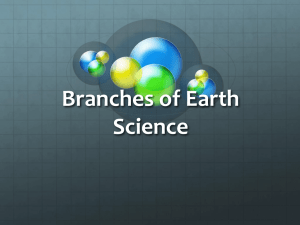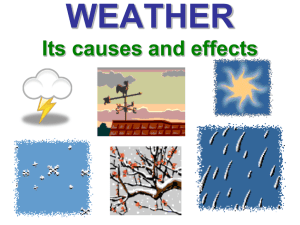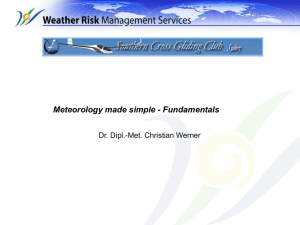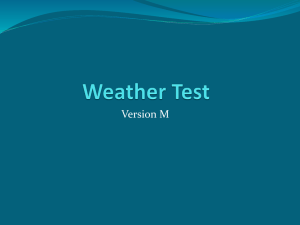Met 61 - San Jose State University
advertisement
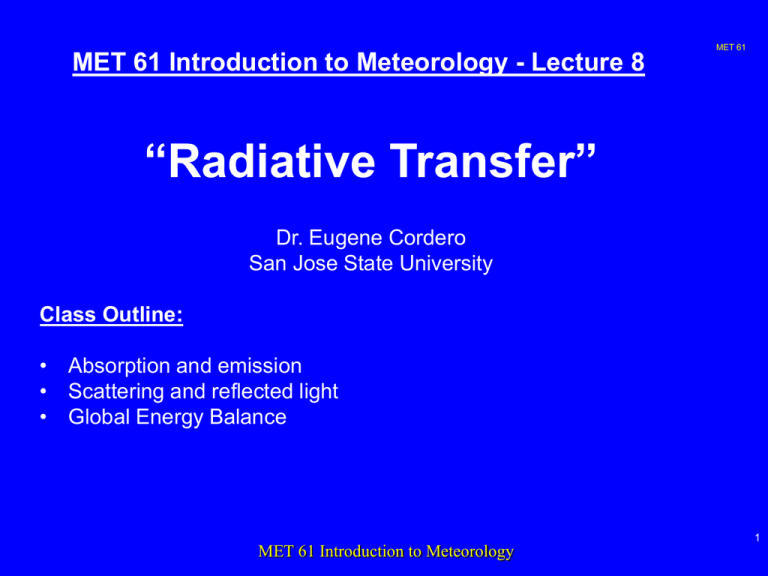
MET 61 MET 61 Introduction to Meteorology - Lecture 8 “Radiative Transfer” Dr. Eugene Cordero San Jose State University Class Outline: • Absorption and emission • Scattering and reflected light • Global Energy Balance 1 MET 61 Introduction to Meteorology Radiation Emission MET 61 • B - Monochromatic Irradiance (Plank’s Law) • F - Irradiance (Stefan Boltzmann Law) • max – Peak emission at a wavelength 2 MET 61 Introduction to Meteorology Energy distribution MET 61 • Radiative energy propagates at speed of light. • Energy per unit area decrease as square of distance from emitter: R1 F2 F1 R2 2 R1,, R2=radius 5 MET 61 Introduction to Meteorology Example MET 61 • Estimate the value of the solar constant; the irradiance at the top of the Earth’s atmosphere. 6 MET 61 Introduction to Meteorology Solution MET 61 earth sun 7 MET 61 Introduction to Meteorology Example MET 61 • Estimate the value of the solar constant; the irradiance at the top of the Earth’s atmosphere. Given 5780 K Given:::T Tsun 5780 K Given T 5780 K sun sun Given : Tsun 55780 K 55 km R 6 . 9 x 10 sun R sun 6.9 x10 5 km Rsun sun 6.9 x10 km 88 8 km R 111...49 xxx10 Rearth 49 10 km R 49 10 8 km earth earth Rearth 14.49 x10 km 8 * 444 44 88 111 444 777 222 * E 67 10 Wm K 5780 K 32 10 Wm F 4 666...32 F111* TT 555...67 xxx10 K xxx10 E T 67 10 Wm K 5780 K 32 10 Wm 4 8Wm 1K 45780 7Wm 2 E T 5.67 x10 Wm K 5780 K 6.32 x10 Wm 1 * * 22* 2 2 E F F E E 222 111 2 1 222 2 RR R E F R E E RR R R * * 111* 1 222 2 S-Solar Constant 555 6 . 96 x 10 * 7 22 6.96 x10 5 km 22 7 km * 7 2 2 F F22* 66..32 xx10 Wm 1372 Wm 6 . 96 x 10 km E 32 10 Wm 1372 Wm 7 2 2 8 2 8 1 . 45 x 10 km E2 6.32 x10 Wm 1.45 x108 km 1372Wm 161 .45 x10 km MET Introduction to Meteorology 8 Absorption, Reflection and Transmission MET 61 • - emissivity: Fraction of blackbody that is actually emitted (0-1) • a - absorptivity: fraction of radiation striking an object that is absorbed. • t - transmissivity: fraction of radiation striking an object that is transmitted. • r - reflectivity: fraction of radiation striking an object that is reflected. • Energy is conserved, so: a + r + t = 1 MET 61 Introduction to Meteorology 10 Or in terms of irradiance MET 61 B absorbed a absorptivity B incident B transmitted t transmissi vity B incident B reflected r reflectivity B incident 12 MET 61 Introduction to Meteorology Kirchhoff’s law MET 61 • Describes how good emitters are also good absorbers a • This relationship is wavelength dependent. • Albedo considers the net effect over a range of wavelengths. Freflected A Fincoming 14 MET 61 Introduction to Meteorology MET 61 15 MET 61 Introduction to Meteorology MET 61 16 MET 61 Introduction to Meteorology MET 61 Activity 7 Inclass question: If the Earth’s albedo was to increase by 10%: • A) By how much would surface solar radiation change? • B) How would the Earth’s surface energy budget change? • C) How would the Earth’s top of the atmosphere budget change? 17 MET 61 Introduction to Meteorology Energy Balance MET 61 • Energy at any level must be in balance: Energy in = Energy out Example: Calculate the blackbody temperature of the earth assuming a planetary albedo of 0.3 and that the earth is in radiative equilibrium 18 MET 61 Introduction to Meteorology Solution MET 61 • F (in; solar) = F (out; terrestrial) S F S(1 - A)πR E(4πR ) S(1 R )) S(1 -- A)π A)πR R E(4π F(4πR 2 E (1 A)S/4 241 W/m22 F 241 W/m F (1 (1 A)S/4 A)S/4 241 W/m TE 255 K T 255 K TEE MET 255 K to Meteorology 61 Introduction 2 2E 2 E E 2 2 2E E E 20 Example MET 61 • A completely gray surface on the moon with an absorptivity of 0.9 is exposed to overhead solar radiation. What is the radiative equilibrium temperature of the surface? 21 MET 61 Introduction to Meteorology Solution MET 61 • Since the moon has no atmosphere, the incoming solar radiation is the total incident radiation upon the surface. For radiative equilibrium: absorbed )) E F F((emitted EE((absorbed E emitted)) 2 4 2 4 2 4 a x 1380 W/m T 1368 W/m TEEE a x 1380 aa 395KK TTEE 395 E 23 MET 61 Introduction to Meteorology Atmospheric absorption MET 61 • The amount of radiation that is absorbed by the atmosphere is proportional to the number of molecules per unit area that are absorbing. B B exp( ) sec k dz z • • • • (sigma) – optical depth or optical thickness k- absorption coefficient (m2/kg) - density (kg/m3) Angle of incidence (from vertical) 24 MET 61 Introduction to Meteorology MET 61 • So the transmissivity of the layer is now: B transmitted t exp( ) B incident • And neglecting scattering, then the absorptivity is: a 1 t 1 exp( ) 26 MET 61 Introduction to Meteorology Example MET 61 • Parallel radiation is passing through a layer 100m in thickness containing a gas with an average density of 0.1 kg/m3. The beam is directed at 60° from normal to the layer. Calculate the optical thickness and transmissivity and absorptivity of the layer at wavelength where the absorption coefficient is 10-1. 27 MET 61 Introduction to Meteorology Solution MET 61 • Assuming the absorption coefficient and density do not vary within the layer: σ k λλsecφ ρdz σ 10 11 2 0.1kg/m 33 *100m 2 • t=0.135 • a=0.865 29 MET 61 Introduction to Meteorology Sun angle MET 61 30 MET 61 Introduction to Meteorology MET 61 31 MET 61 Introduction to Meteorology MET 61 33 MET 61 Introduction to Meteorology MET 61 What month do you think this graph represents? a) December b) March c) June d) September 34 MET 61 Introduction to Meteorology MET 61 What month do you think this graph represents? a) December b) March c) June d) September Answer: December 35 MET 61 Introduction to Meteorology MET 61 36 MET 61 Introduction to Meteorology Simplified radiative energy cascade for the Earth-atmosphere climate system Reflected Planetary Albedo Extraterrestrial Short Wave Radiation Energy Input Extraterrestrial Short Wave Radiation Solar Temperature E-A Climate System Energy Output Terrestrial Long Wave Radiation Planetary Temperature MET 61 Assigned Reading for Feb 14 • Ahrens Ch 2 (continuing) • Stull Ch 2: Pages 26-28 • Quiz 1 (30 minutes) on Feb 16th from material through Feb 14th. 38 MET 61 Introduction to Meteorology Activity 7: Due March 21st MET 61 • Question 1: Concrete has an albedo of around .25 and yet the typical infrared emissivity of concrete is 0.8. Explain why these are different and the implication of this on climate change? • Question 2: Consider a flat surface subject to overhead radiation. If the absorptivity is 0.1 for solar radiation and 0.8 in the infrared, compute the radiative equilibrium temperature. • Question 3: Calculate the radiative equilibrium temperature of the Earth’s surface and Earth’s atmosphere assuming that the earth’s atmosphere can be regarded as a thin layer with an absorptivity of 0.1 for solar radiation and 0.8 for terrestrial radiation. Assume the earth’s surface radiates as a blackbody at all wavelengths. 39 MET 61 Introduction to Meteorology

